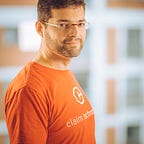If your claims software was Tesla.
Three years ago, I went to a ‘Company Formation’ agent. The verb ‘to form’ is a fancier alternative than the verb ‘to make’. But I wasn’t interested in forming a company at all. I wanted ‘to create’ one.
There is a world of difference between the two. To make or form something is about replicating something that already exists. To create is to bring something new into the world. Most start-ups I see are generally replicating an existing model. Granted they may be a little shinier on the outside, but the difference between them and the past is skin-deep. It takes a certain mind to see beyond perceived wisdom and to understand deep, structural issues with an existing industry domain or technology, and to leverage that insight to create something fundamentally different.
Creators usually stand alone. It’s that certainty you have inside where the whole of the world seems to be on one side and only you are on the other. Is the whole world mad, where only I can see things as they are, or is it me that is mad? You remain certain.
We understand creation when we see it or feel it, even if we don’t understand it. I’ll put art, music and literature to one side and try to think of a commercial example; remember the first time you ate a Haagen Dasz (something other than vanilla, strawberry or chocolate??), or saw an iPhone for the first time (where are the buttons?), or ordered your first Uber (I can see you coming). In that moment, you experienced the difference created by a single mind who had the courage to defy conventional thought. In that moment, you crossed to the other side to join the creator, wondering how it could ever have been otherwise.
Without access to either offices or staff, the current pandemic has accelerated the awareness and motivation of many sectors to achieve digital transformation, which is needed most of all in my own sectors of expertise (insurance and legal). It is both the language being used and its meaning that has changed. Being digital means something other than digitising. Transformation means something other than just incrementally improving a legacy model. The insurer-centric model, which has pushed what it believes the customer needs or wants, could give way to a customer-centric model. Insurance could move from being a reactive, loss re-imbursement industry — we promise to payout when things go wrong (until they don’t) to a pro-active, loss prevention industry and instant claim settlement industry (what customers actually value).
This awareness couldn’t come at a better time for my start-up whose mission, was to make insurance claims faster, easier and cheaper. The problem we face now is two-fold. The first is that whilst awareness has accelerated, the industry incumbents haven’t yet accelerated their motivation to act. The second is the sheer noise from either the legacy vendors presenting their new cloud offer or eco-system as a digital silver bullet, or by newer vendors whose solutions may be more modern but suffer from the same design flaws caused by legacy thinking. It’s as-if every insurance technology vendor is now a specialist in artificial intelligence, robotic process automation and micro-services, but when asked none can really define what these are and how they relate to each other.
Vendors jumping on the proverbial bandwagon and making false claims about what they can do has always irritated me. But it also forces me to think more deeply on whether we have created something genuinely different (I’ll let our customers be the judge of that) and how we differentiate ourselves from would-be competition.
I will do so by way of analogy. To the untrained eye, a Toyota and Tesla are both cars. Both get you from A to B and provide a comfortable customer experience. But there is a fundamental difference between the two. A Toyota is a combustion engine/set of wheels with an increasing amount of computing added on-top. A Tesla is the opposite. It’s a computer on top of a set of wheels. To the untrained eye the cost per mile is significantly lower with a Tesla. To the trained eye, Tesla has created a model that breaks legacy. Whereas the Toyota will age and deteriorate over time, a Tesla becomes faster and more efficient over time, as automatically published software updates improve driving range. As the initial purchase cost of a Tesla drops ever closer to Toyota, so too does Toyota’s inability to compete, to the point of possible extinction. Investors think so too. Despite Toyota selling 30x as many cars, it’s market value is lower than Tesla.
So too with insurance. To the untrained eye, most insurance software seems the same. But there is a fundamental difference between a technology stack that has been designed on the assumption that a claims handler will always be there to process the claim (the legacy model creating $140bn in annual claims processing costs for Property & Casualty policies alone), and the opposite — a technology stack that was designed on the assumption that there may be no human claims handler in the loop. By thinking in terms of eliminating a conscious human from the process, Claim Technology had to develop a “conscious machine” instead. To the untrained eye, the operational processing cost has dropped. To the trained eye, Claim Technology has created a model that breaks legacy. Whereas other vendor solutions will deliver ever smaller incremental improvements with time, businesses powered by Claim Technology (whether they are insurers, insurtechs, 3rd party administrators etc) will become ever more agile, faster and efficient over time.
I’ll leave it there for now, but it isn’t enough to read about it. Like a Tesla, to be really understood it has to be experienced. If you haven’t already started your trial, email us at hello@claimtechnology.co.uk and let’s start making insurance better, together.
